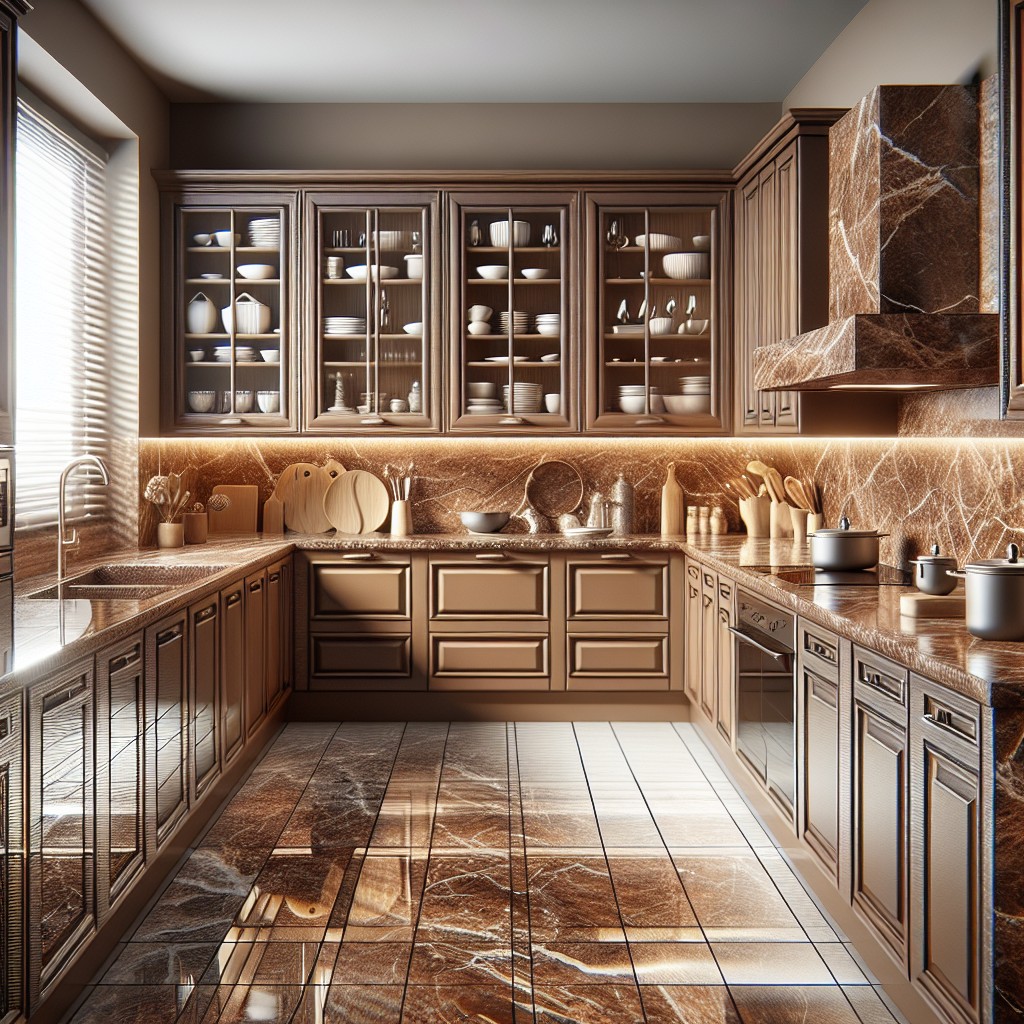Last updated on
Transform your windows into stunning focal points because this article will be brimming with creative, ornate window trim ideas to elevate your aesthetic.
These are my unique design concepts made using design tools. I hope you find them inspiring!
Discover the art of window trim. Embark on a journey through unique, innovative ornate designs that infuse panache into your home décor.
This article goes beyond the repetitively regurgitated information saturating the internet, offering a plethora of fresh perspectives and ingenious trim ideas.
In addition, it provides valuable resources correlating with time-tested favorites.
Be prepared to stretch your imagination, as these new concepts in window trim design will invigorate your creativity and take your home aesthetics to the next level.
What's Inside
Vintage Inspired Ornate Trim
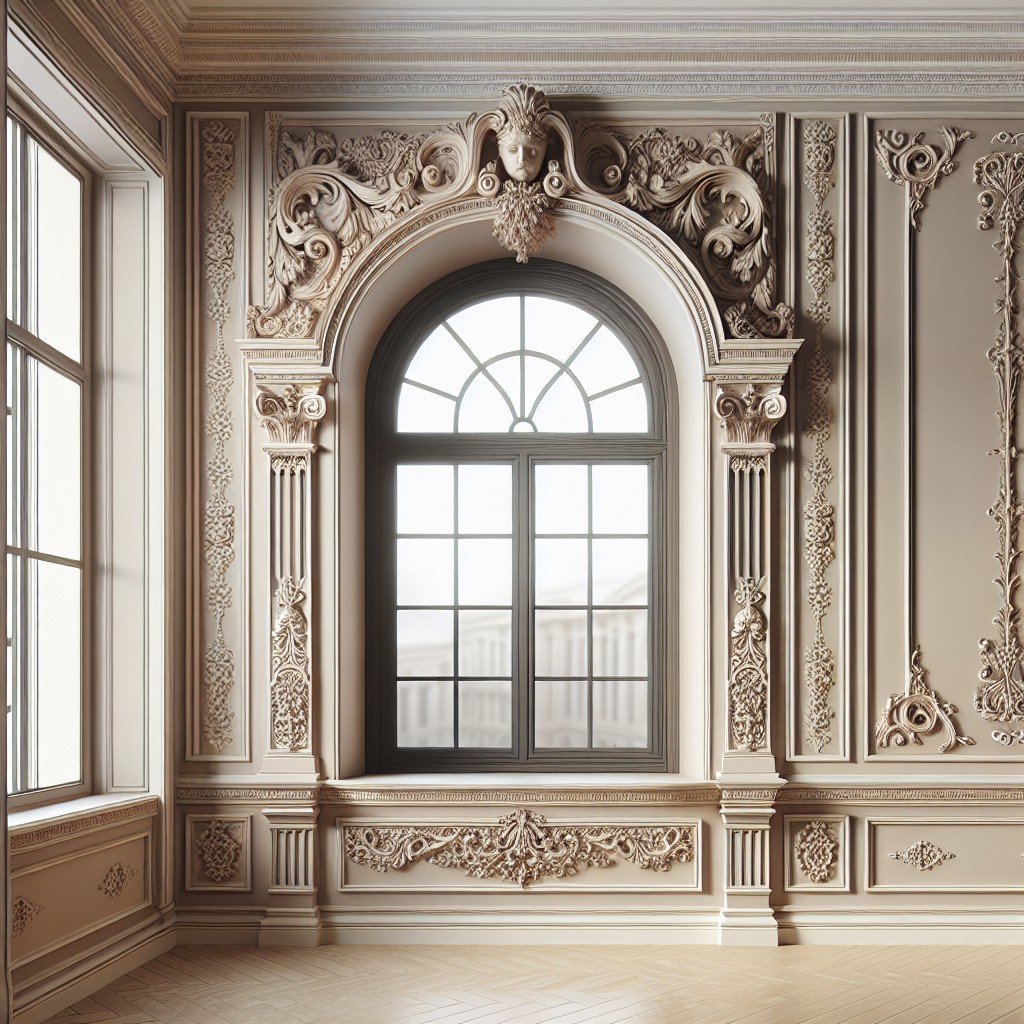
Often drawing inspiration from past eras, this style combines intricate carvings, muted color tones and often feature curves instead of linear designs. The beauty lies in the artistry of each piece, creating a timeless appeal.
Here are notions to consider for this style:
- 1. Opting for Wood: Hardwoods such as oak or mahogany often provide durability and intricate carving capabilities.
- 2. Detail and Texture: More than just a frame, incorporating elements like carved rosettes, fluted casing or corner blocks can add an additional layer of sophistication.
- 3. Antiquing Techniques: Weathering or distressing wood, using milk paint finish, or utilising patina effect can reveal an authentic aged look.
- 4. Soft Color Palette: Creams, whites, and other soft hues often pair well, letting the carvings and details take the limelight.
Remember, the overall goal is to grant your windows an echo of the past and elaborate detailing of the vintage era.
Window Trim With Stonework Detail
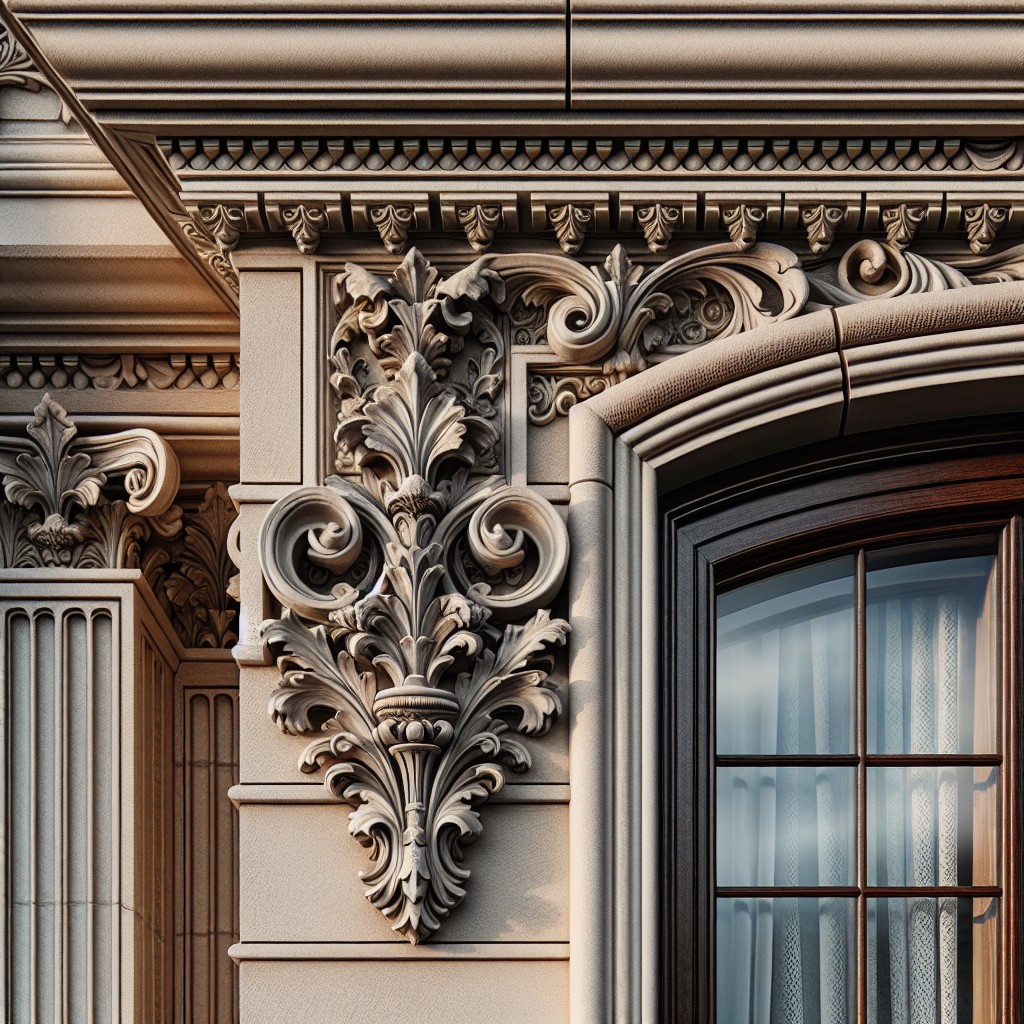
Expanding on the captivating, crafted charm, stonework adds a unique element to your window trim. Displaying an exterior or interior aesthetic, these designs elevate the mundane to magnificent. There are a few key things to consider with this style:
1. Use: Stonework can complement both modern and traditional style homes. It also works well for adding a rustic touch to farmhouse or cottage designs.
2. Type of Stone: You can select from a variety of stones such as cobblestone, flagstone, or river rock. It depends on the desired look. Remember, each stone offers a different level of ornateness and intricacy.
3. Color and Texture: It isn’t just about the stone type. You also want to think about the color and texture. Light-colored stones can brighten a room, while darker ones may create a cozier feel.
4. Design: Stonework can wrap around the entire window or be used only in specific areas. Stones can be arranged in orderly patterns or sporadic layouts for a more natural look.
5. Maintenance: Generally, stonework requires minimal upkeep but make sure any grout or sealant used is durable and weather-resistant.
With these notes, you can harness the beauty of stonework detail to enrich your window trims. Bear in mind the overall style and decor of your home to ensure a cohesive look.
Touch of Gold Embellishments
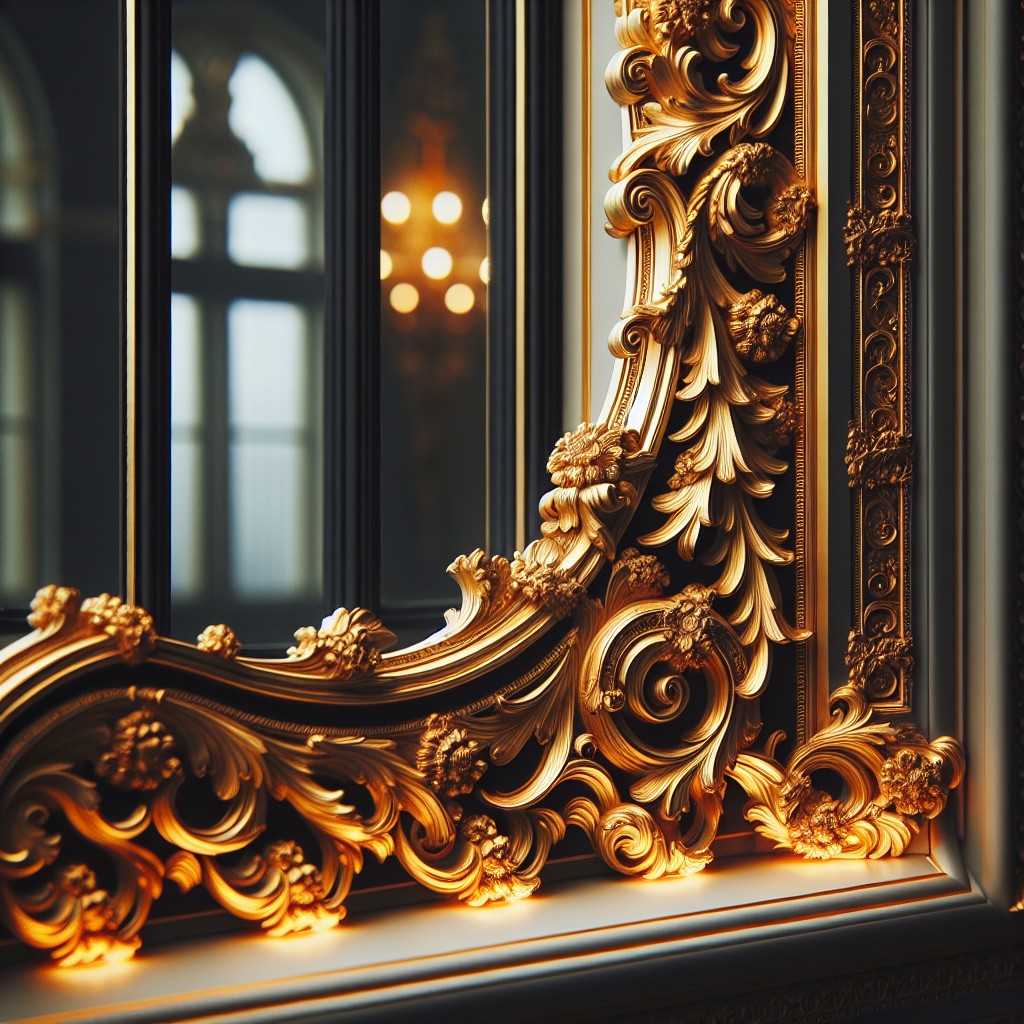
Injecting a touch of gold into your window trims can reflect an opulent aesthetic and adds a luxe vibe. Just a little goes a long way with gold embellishments – utilizing it in perfect harmony with other trim elements rather than allowing it to overpower your design is crucial.
These embellishments can be incorporated in various forms:
- Gold leaf application, which adds a delicate luster reflecting natural light in unique ways.
- Abstract gold pattern detailing, enhancing the overall aesthetic of the window trim.
- Small gold rosettes or medallions, dotted along the trim to add flair.
- Gold paint or thin gold strips, creating an appealing contrast with a matte or dark wood trim background.
- Ornate gold carvings, showcasing a meticulous craftsmanship for those who appreciate intricate designs.
Remember, it’s all about achieving a balance between elegance and flashiness. Too much gold could possibly detract from the overall decor, but smart use can uplift any window setting in an instant, providing a touch of regal luxury.
Floral Carving Window Trim
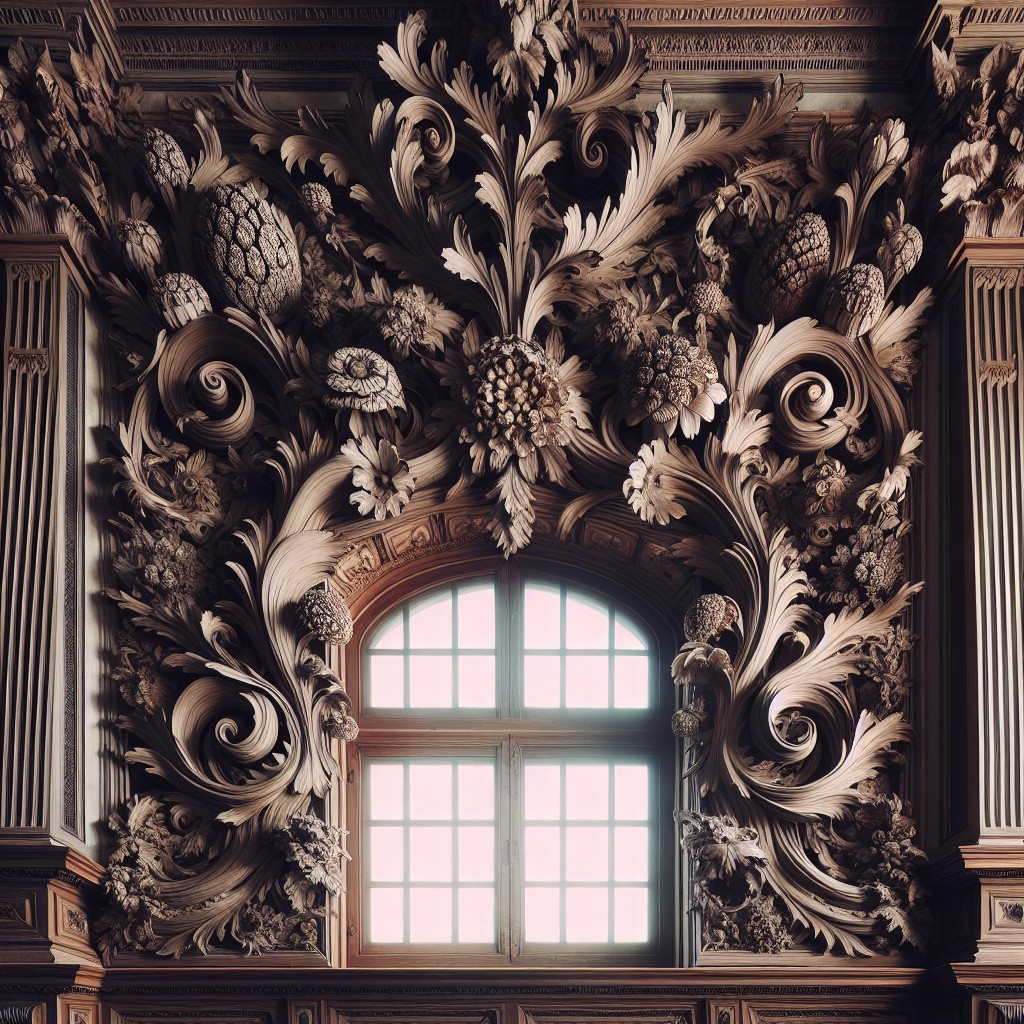
Taking its inspiration from the beauty of nature, a floral carving detail adds a sense of elegance and delicacy to any window frame. These designs can range from simple, understated flowers carved directly into the trim to more detailed, three-dimensional carvings of florals and foliage. It’s a timeless look that brings elements of the outdoor beauty indoors.
Considering their detailed nature, floral carvings are more suited to larger window frames where the design can be fully appreciated. They work especially well in traditional or vintage-inspired interiors, as they add a hint of nostalgia and sophistication.
To really make the floral carvings pop, consider painting them in a contrasting color to the rest of the window frame. This contrast draws the eye and allows the detailed carvings to take center stage. Alternatively, leave them unpainted for a more natural or rustic feel.
Whatever your choice, the implementation of floral carving window trim promises a unique addition to any home decor. Remember, the possibilities are vast where one can mix and match with different interior styles, stray from orthodox designs, and let the flowers bloom in their unique splendor on your window trims.
Stained Glass Window Trim
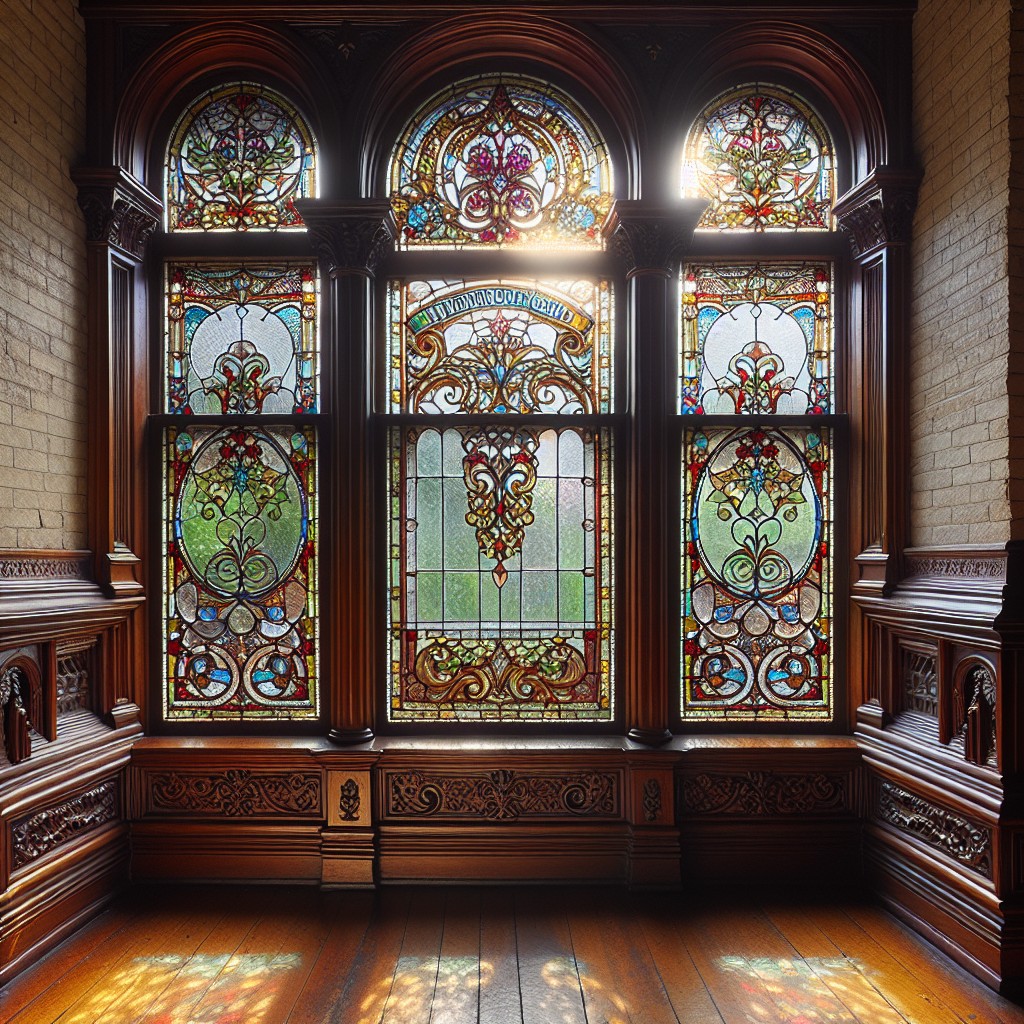
Incorporating rich and bright colors along with unique patterns, this option infuses both elegance and playful aesthetic into your space. Users can choose designs ranging from traditional to abstract to match their interior decor.
Additionally, the stained glass itself can serve as a beautiful artistic focal point, negating the need for further window treatments. Notably, when sunlight infiltrates, it creates a mesmerizing luminous effect, bathing the room in vibrant light shades.
This trim style may require professional installation to ensure accurate fit and finish. Keep in mind, although it’s highly decorative, it’s also less flexible when it comes to updates or changes in color scheme compared to other trim styles.
Iron Lace Window Trim
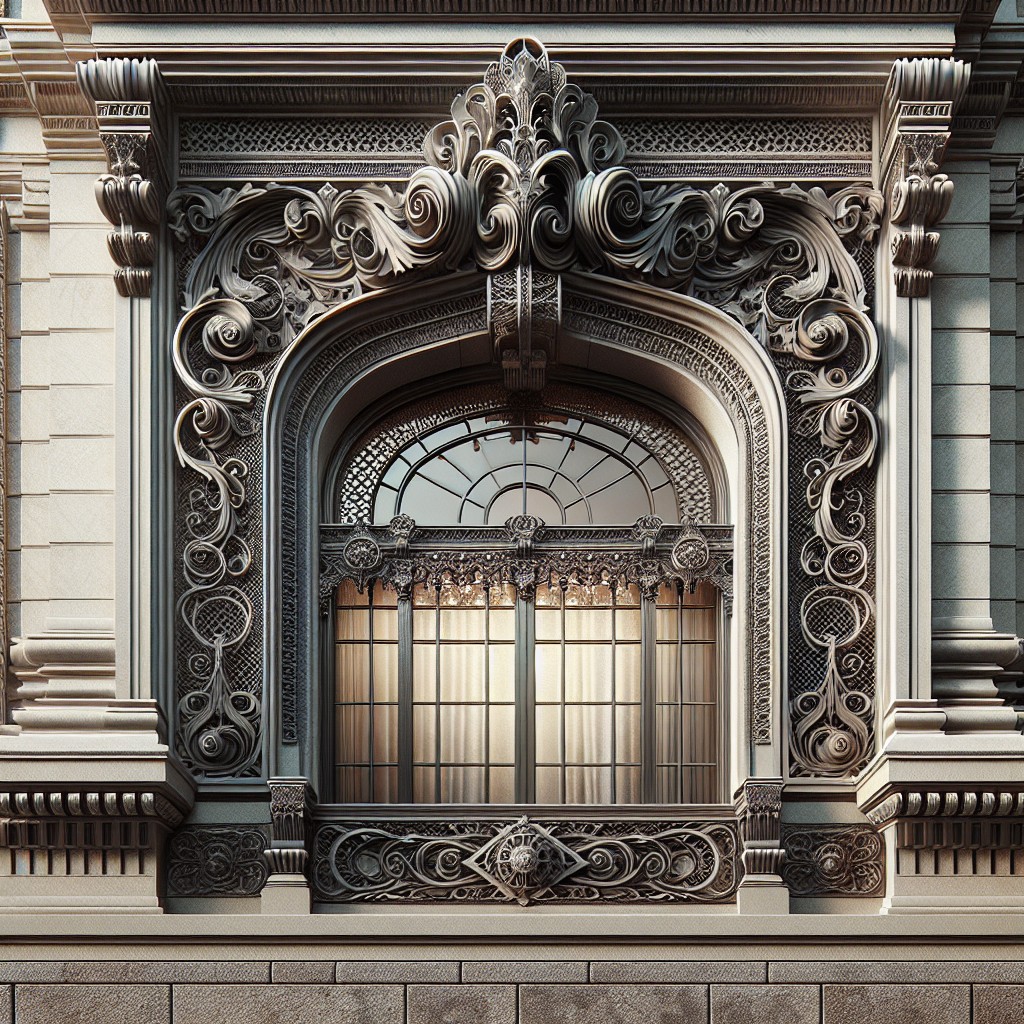
Iron lace offers a delicate and intricate charm that effortlessly elevates the aesthetics of any window. Commonly flaunting elaborate designs, this style encapsulates Victorian-era elegance and modern craftsmanship.
Here are a few noteworthy aspects:
- Materials: Often made from wrought or cast iron, it’s durable and withstands harsh weather conditions.
- Design: Featuring intricate patterns, it can range from floral motifs to geometric sequences, providing a unique aesthetic appeal.
- Finishing: It can be painted or powder-coated ensuring it complements the color palette of your home.
- Installation: Despite its sophisticated look, iron lace trims can be installed fairly easily and securely.
- Versatility: Ideal for both interior and exterior applications, this trim style suits a variety of architectural designs.
- Maintenance: Usually requiring minimal upkeep – a simple dusting or wipe-down to keep it looking its best.
Gilded Baroque Style Trim

Taking its bold inspiration from the lavish lifestyles of the 17th and 18th century European nobility, this style is a statement piece that cannot be overlooked. The key elements are its intricate designs, large flourish patterns, and often, the use of gold-leaf foils for enhancing its elaborate aesthetics.
1. Showcase Extravagance: Immerse within intense details that exude luxury. This style’s richness captivates the onlooker’s attention.
2. Gold Leaf: Exquisite gold-leaf details give this trim its ‘Gilded’ name. The gold glimmer builds an elevated atmosphere, transforming a simple window frame into a work of art.
3. Symmetry: Despite its flamboyant designs, balance plays an important role. This symmetry within complexity demands skill and precision.
4. Curves and Swirls: The framing involves heavy use of curves, swirls, and spirals, meant to reflect the opulence of the Baroque period.
5. Floral and Foliage Motifs: This trim often incorporates the designs of leaves or flowers, weaving natural elements into its complex patterns.
Implementing this trim in your living space provides a royal touch; however, be cautious as its striking nature may overshadow simpler design elements if not harmoniously integrated.
Greek Revival Window Trim
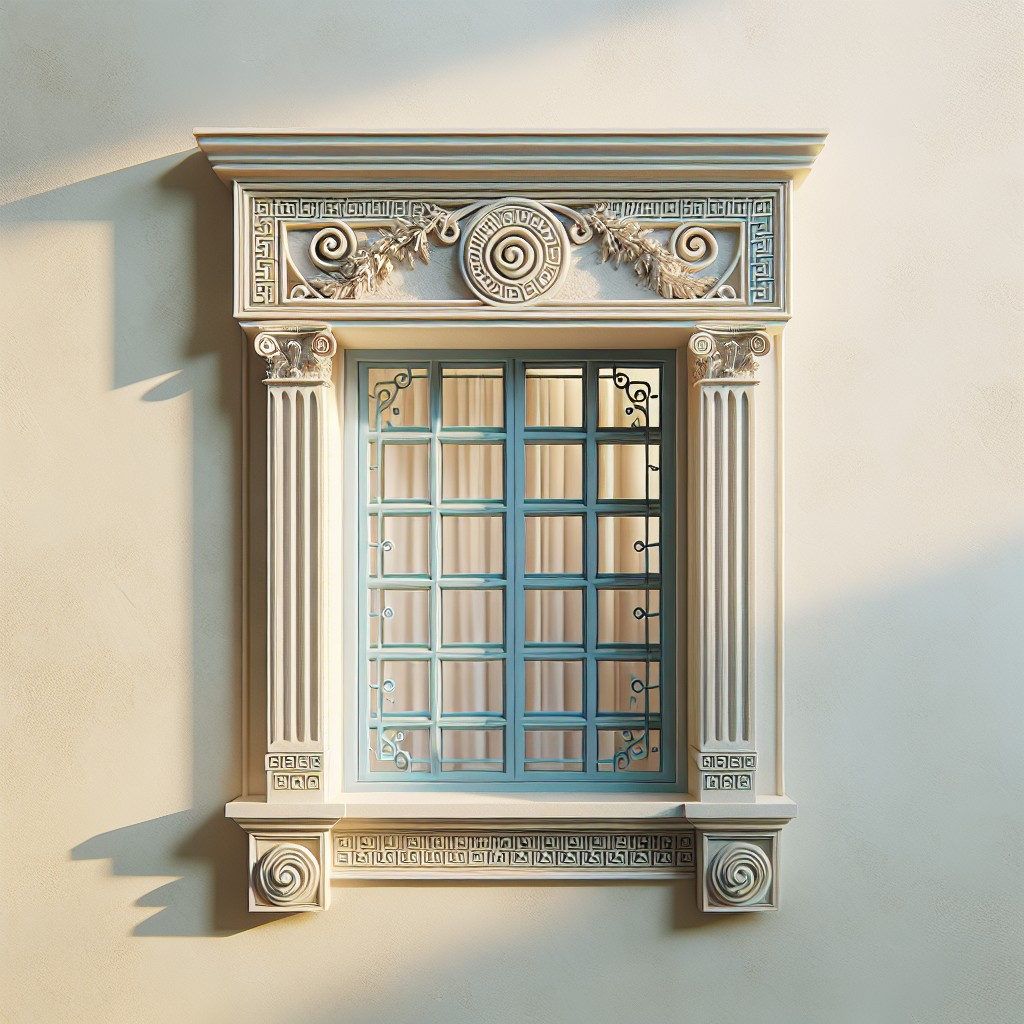
Taking cues from the architectural grandeur of ancient Greece, this particular trim bears hallmarks such as dentils or overly prominent cornices. Typically featuring a strong linear emphasis, and a frieze decorated with symmetrical reliefs or greek key patterns, it gives a sense of balance and proportion.
Forms and entablature often stand boldly against contrasting, usually white, window frames and sashes, providing a compelling aesthetic. It’s an ideal choice if you’re aiming for an elegant and timeless look on your window trims. Despite its antiquity, this style retains classic elegance that sits well even with modern architecture.
Art Nouveau Inspired Trim
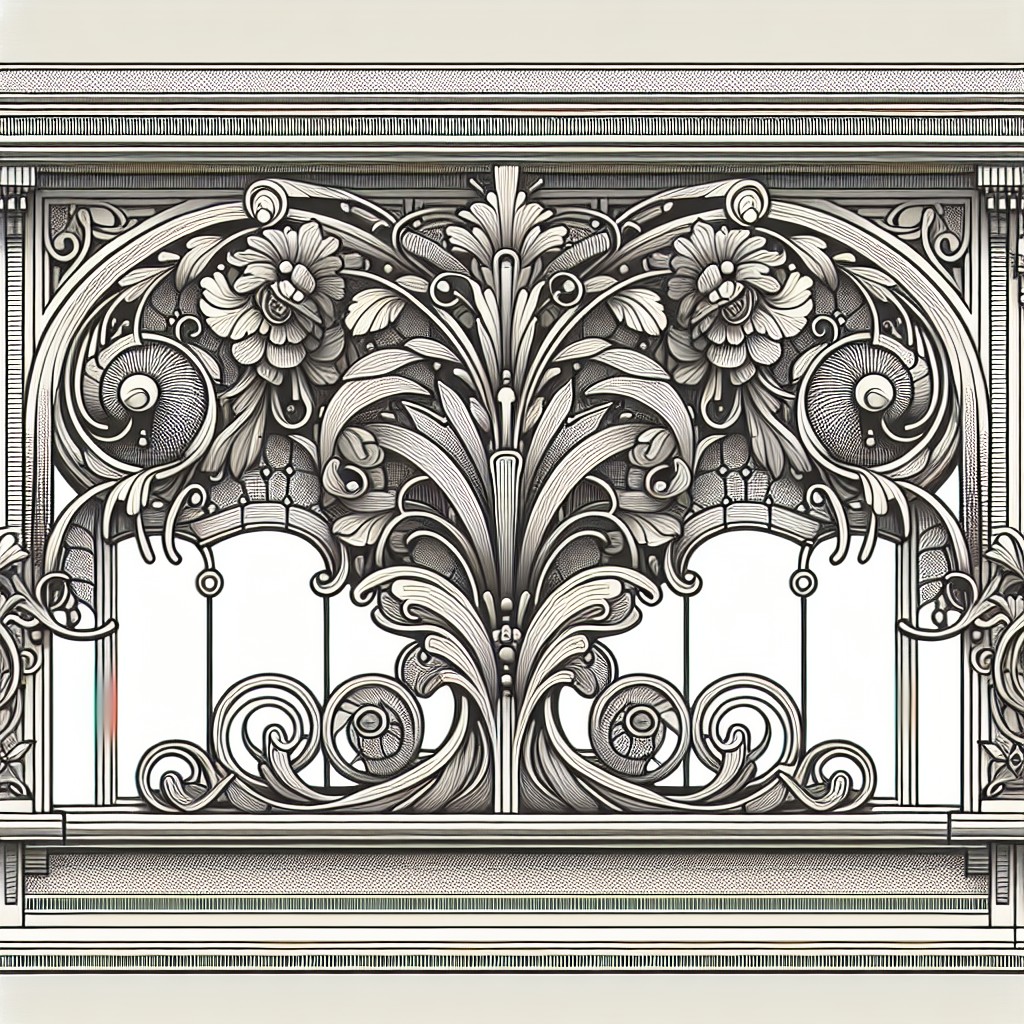
Featuring soft, organic lines and intricate detailing, this type of trim draws directly from the natural world. Art Nouveau, an international art movement, enamored audiences in the late 19th and early 20th centuries with its elegant, flowing forms and use of flora and fauna motifs.
1. Curvilinear designs: Shapes are gracefully abstract, with flowing curves and waves often used.
2. Nature motifs: Examples may include petals, vines, or the famed “whiplash” curves resembling plant stems.
3. Handcrafted feel: Despite often complex form and detail, Art Nouveau trim retains a handcrafted look, adding warmth and individuality.
4. Unique materials: Wrought iron, bronze, or stained glass may be utilized, enhancing the distinctive charm of this trim style.
5. Integration with architecture: Grab inspiration from the naturalistic, organic shapes in many Art Nouveau buildings. This trim style lends itself well to blending with arches, columns, or other architectural features.
Remember, the aim is to create a refined balance between simplicity and luxurious detailing, characteristic of the Art Nouveau movement.
Window Trim With Celtic Knot Detail
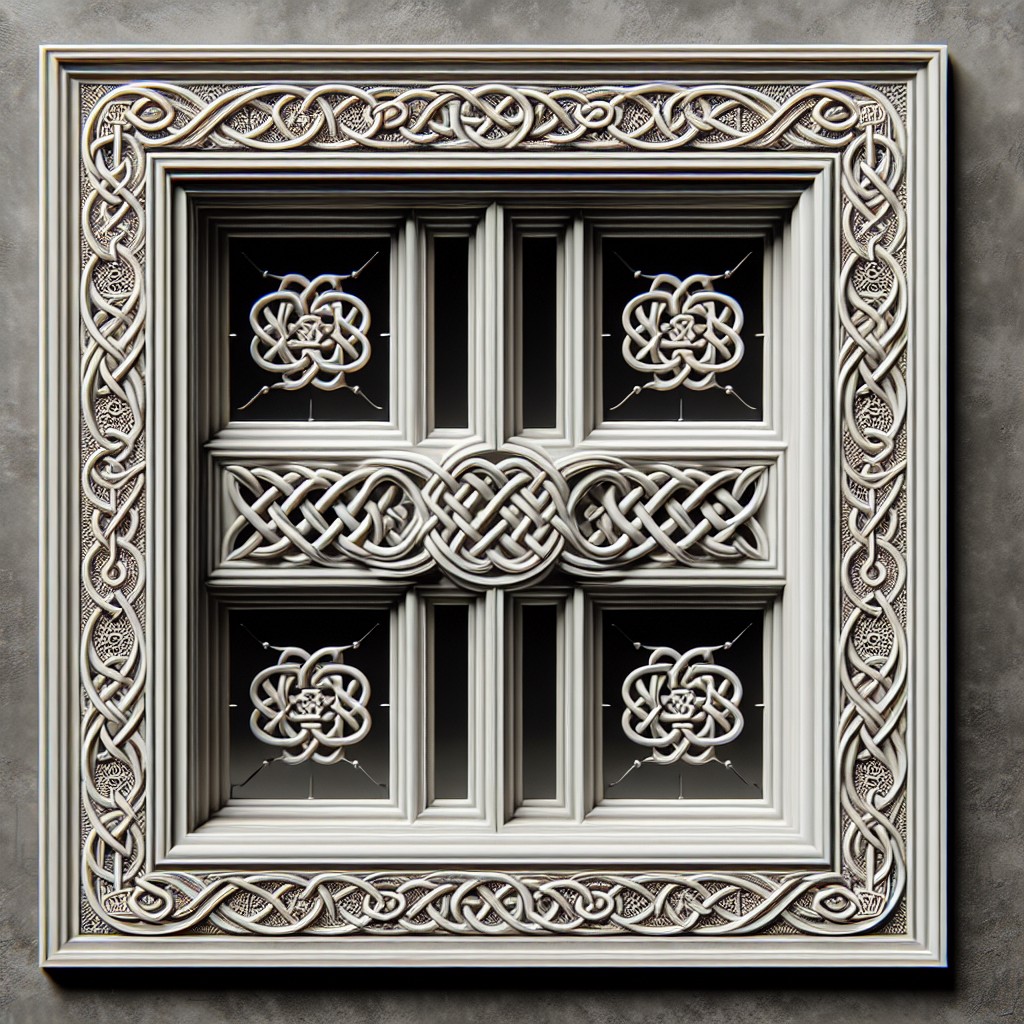
This style is deeply rooted in history, derived from ancient Celtic symbolism lending a cultural and artistic touch to the window. It can make your home look unique and emit a subtle charm, while also providing a conversation piece due to its rich background.
1. Design Basics: Typically, this trim style features intricate intertwining lines and curves, forming a continuous loop without a distinct start or end. This is a symbol of eternity and interconnectedness in Celtic culture, making it a meaningful addition.
2. Material Choices: The beauty of this trim type can be customised as per the homeowner’s preference. From painted wood for a modern look to stained wood for a traditional look, you can branch out from typical materials and consider cast-iron or bronze for an added layer of elegance.
3. Customization: You can choose the complexity of your trim ranging from simple to extremely detailed knots which can be tailored to personal style or the existing aesthetic of the home.
4. Versatility: This trim style can be paired with any window type- be it classic bay windows, stylish casement windows, or practical sliding windows.
Remember, the key is to balance intricacy with the overall design theme of your home for a harmonious visual appeal.
Geometric Shaped Window Trim
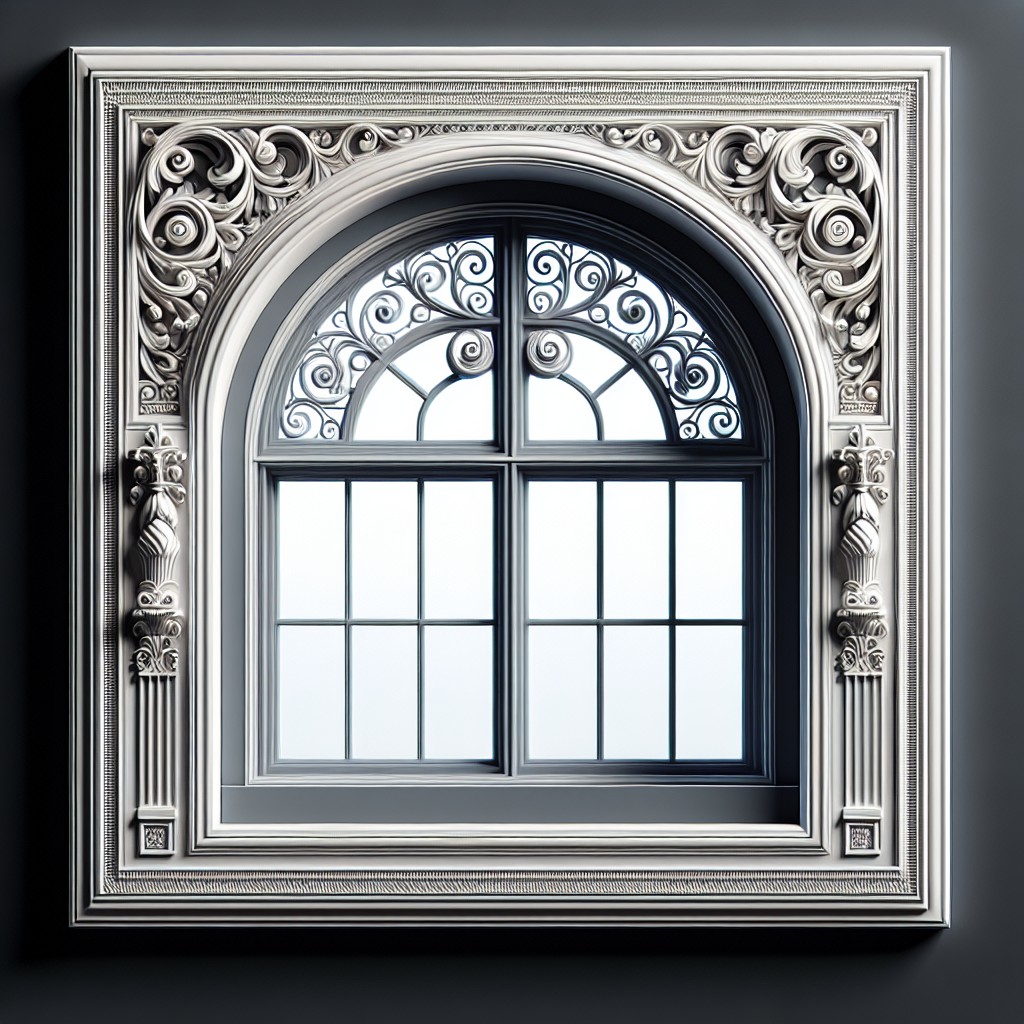
Exploring shapes beyond standard rectangles or squares adds a dimension of modernity mixed with classic elegance. From more sophisticated polygons like hexagons or octagons to more basic shapes like circles or triangles; geometry is at your command.
This trim style can be achieved through textured paint applications, intricate woodwork, or even metal detailing. Contemporary designs often utilize clean, sharp lines to bring focus to the trim, making your windows a striking visual feature. Different angles can also manipulate light differently, casting unique shadows throughout the day.
Such a trim choice brings an element of architectural interest to both interior and exterior facades, giving a bold statement to your home décor.
Oversized Crown Moulding Window Trim
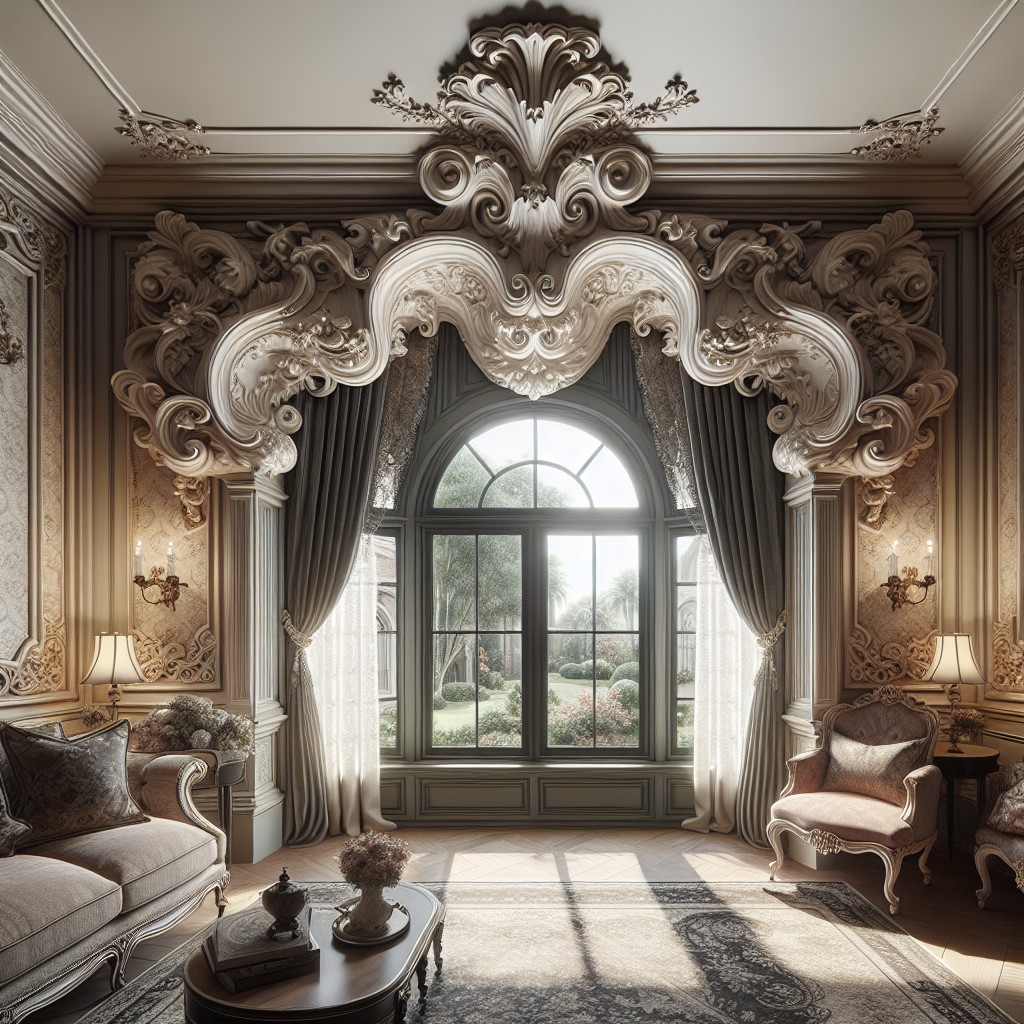
Merging extravagance with regality, this trim style boasts an imposing profile on window frames. Sophisticated and stately, its large dimensions serve not only as robust support but also transform into an impactful design feature.
1. Select from a range of materials: Wood, MDF or Polyurethane all add distinctive qualities.
2. Consider scale and proportions: Ensure the trim balances with the window size and overall room décor.
3. Blend patterns and textures for visual interest: Traditional, modern, or a mix offers design flexibility.
4. Play with paint or stain: Contrasting or blending with wall color creates different effects.
5. Accentuate with details: Complement the moulding with decorative corner blocks or rosettes.
6. Highlight with strategic lighting: Use of uplighting or downlighting gives beautiful shadows and depth.
Vaulted Cathedralesque Window Trim
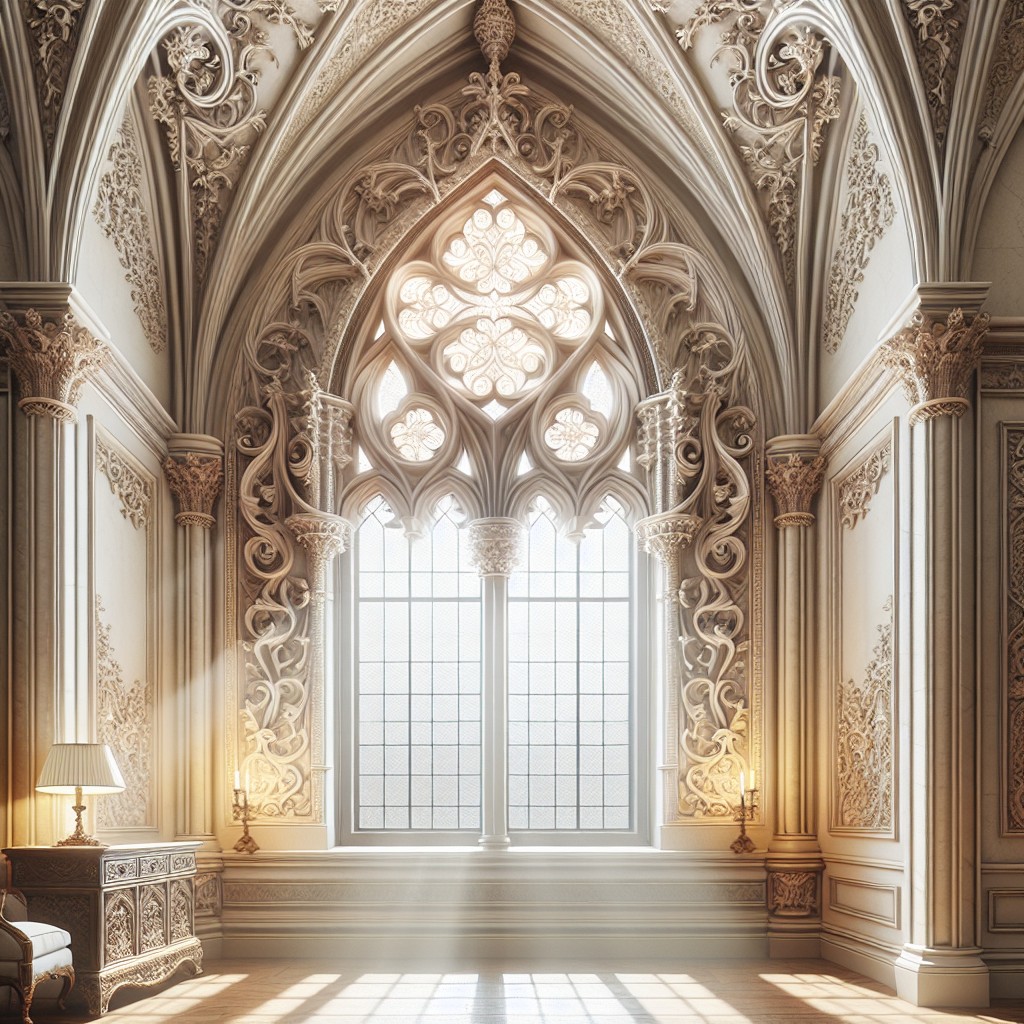
Embodying the grandeur of cathedral architecture, this style is characterized by impressive curves, making your windows a focal point of the room. The design concept behind this trim is to highlight the tall, arching windows that often accompany high ceilings.
Key Features:
- 1. Arched Design: The unmistakable arch, reaching upwards and peaking at a central point, imparts a touch of drama.
- 2. Intricate Carvings: More advanced styles include luxurious carvings often inspired by religious motifs seen in cathedrals.
- 3. Scale: Large and in charge, these trims tend to be larger to suit big windows.
- 4. Materials: Traditionally, solid wood is the material of choice to achieve the structural strength necessary.
Implementation Advice:
Installing this kind of trim requires precision due to its intricate design. Professionals or highly skilled DIYers are best suited for its installation. Its large scale might not work with every type of home, so consider the overall aesthetic of your space before opting for this style.
Gothic Arch Window Trim

Steeped in history, this design flourished during the medieval period. Its singularly distinctive trait is the pointed arch, a stark departure from the rounded roman-esque arches. Ideal for tall windows, it can stretch anywhere from a full semi-circle to a slight rise, always meeting at a sharp peak.
- 1. Works exceptionally well with stone and brick structures.
- 2. Instantly adds a historical and dramatic touch to homes.
- 3. Timeless style that stands out regardless of current architectural trends.
- 4. Versatile enough to blend with other design elements for a unique aesthetic.
- 5. Use of a keystone at the apex adds to the charm and intricacy.
- 6. Complements stained glass or other ornate window designs.
This design is especially alluring to those intrigued by medieval architecture or ornate details invoking the romance of a bygone era.
Roman Ionic Column Inspired Trim
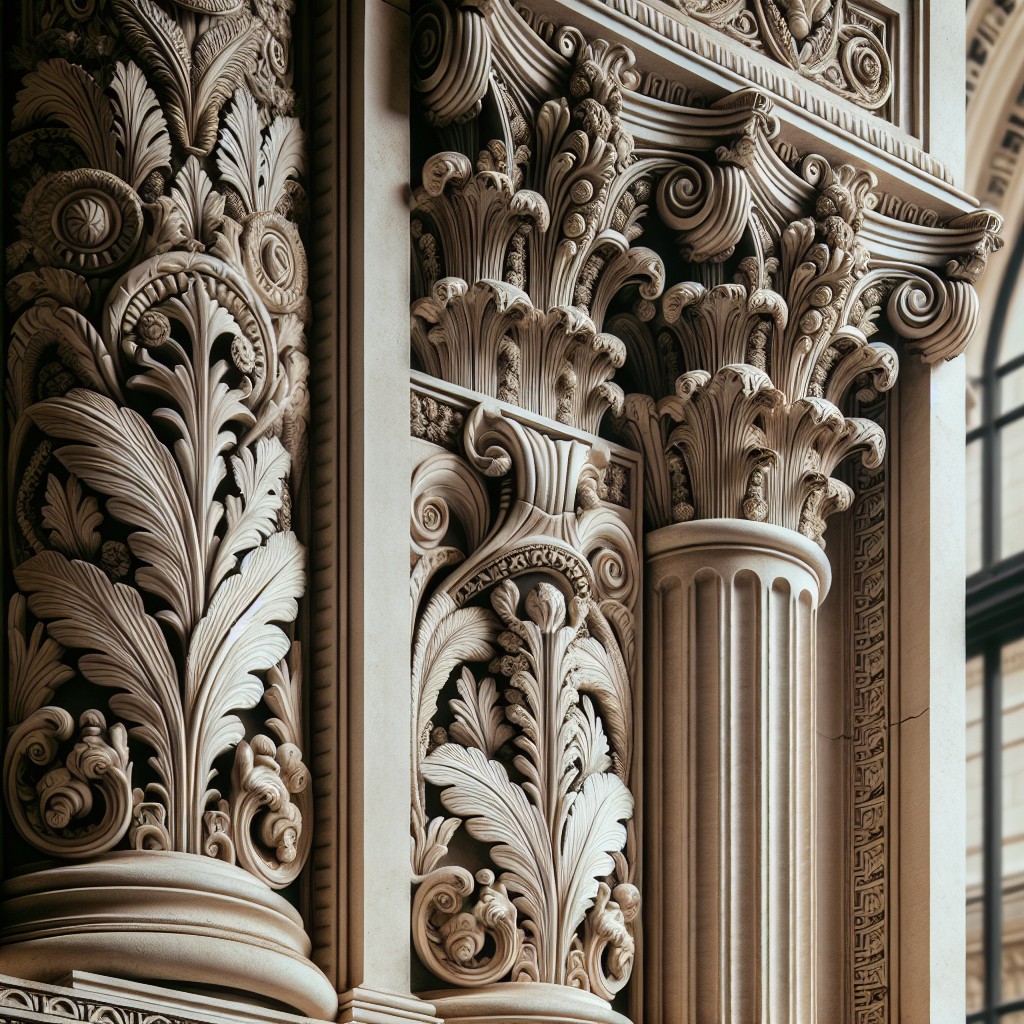
The Ionic style, as exemplified by ancient Roman architecture, is an excellent source of inspiration for a sophisticated statement window trim. Here’s what sets it apart:
1. Scroll-shaped Volutes: The hallmark of the Ionic column style, the volutes are intricate scroll-like motifs, adding a touch of elegance.
2. Frequent Use of Fluting: Fluting refers to the grooves running vertically along the surface. This design element bestows a rhythmic beauty to the window trim.
3. Ornamental Bands: Also known as friezes, these decorative bands enhance the trim’s visual appeal, reflecting the era’s love for detail and ornamentation.
4. Classical Proportions: Harmonious proportions are central to Roman design principles, which translate into balanced aesthetics for the window trim.
5. Use of High Quality Materials: From marble to polished wood, selecting a superior material will echo the Roman focus on durability and grandeur.
Implementing these characteristics can capture the majesty of Roman architecture, lending your window trim a dignified, enduring look.
Moroccan Ornate Window Trim
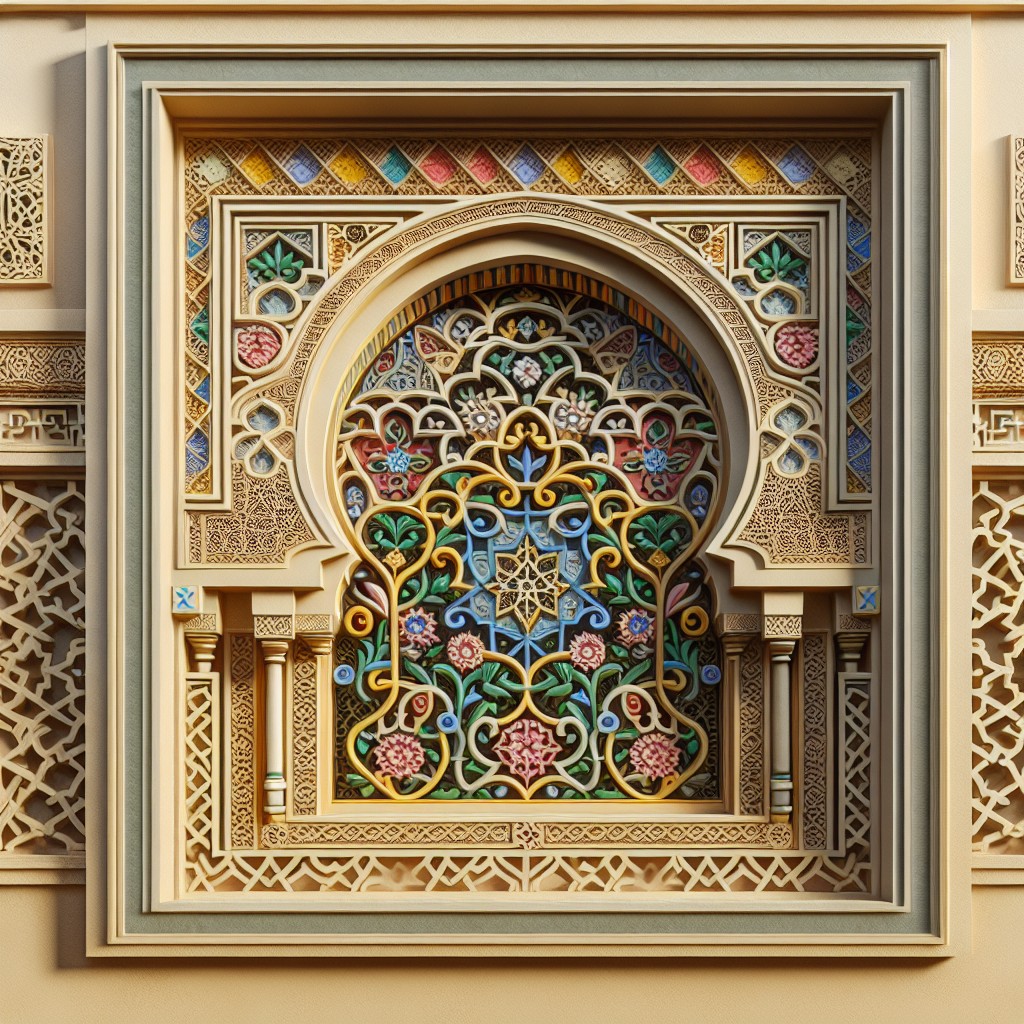
Moroccan designs are rooted in rich traditions and intricate detailing. Each element’s complex geometry forms a distinctive, cohesive whole. This also holds true for their window trims, which showcases careful craftsmanship.
1. Geometric patterns: Intricate, repeatable designs, often forming star or flower motifs, are a characteristic feature of Moroccan window trims. These can provide an attractive focal point, creating dynamic visual interests.
2. Vibrant colors: Moroccan trims traditionally incorporate bold, earthy shades like terracotta, or jewel tones like emerald green, capturing the nation’s natural landscape palette.
3. Quality materials: Moroccan window trims typically use materials like plaster or wood. They can be carved into ornate designs and may be painted or left as is for a more rustic look.
4. Metallic accents: These trims may occasionally include brass or copper accents. Embossed or engraved, they add a touch of luxe.
5. Medallion features: A central medallion, surrounded by the abovementioned geometric patterns, can be a common feature. It further emphasizes the design’s radial balance.
Do remember, while ornate trims are beautiful, they pair best with simpler curtains or blinds to avoid overwhelming the space.
Edwardian Era Window Trim
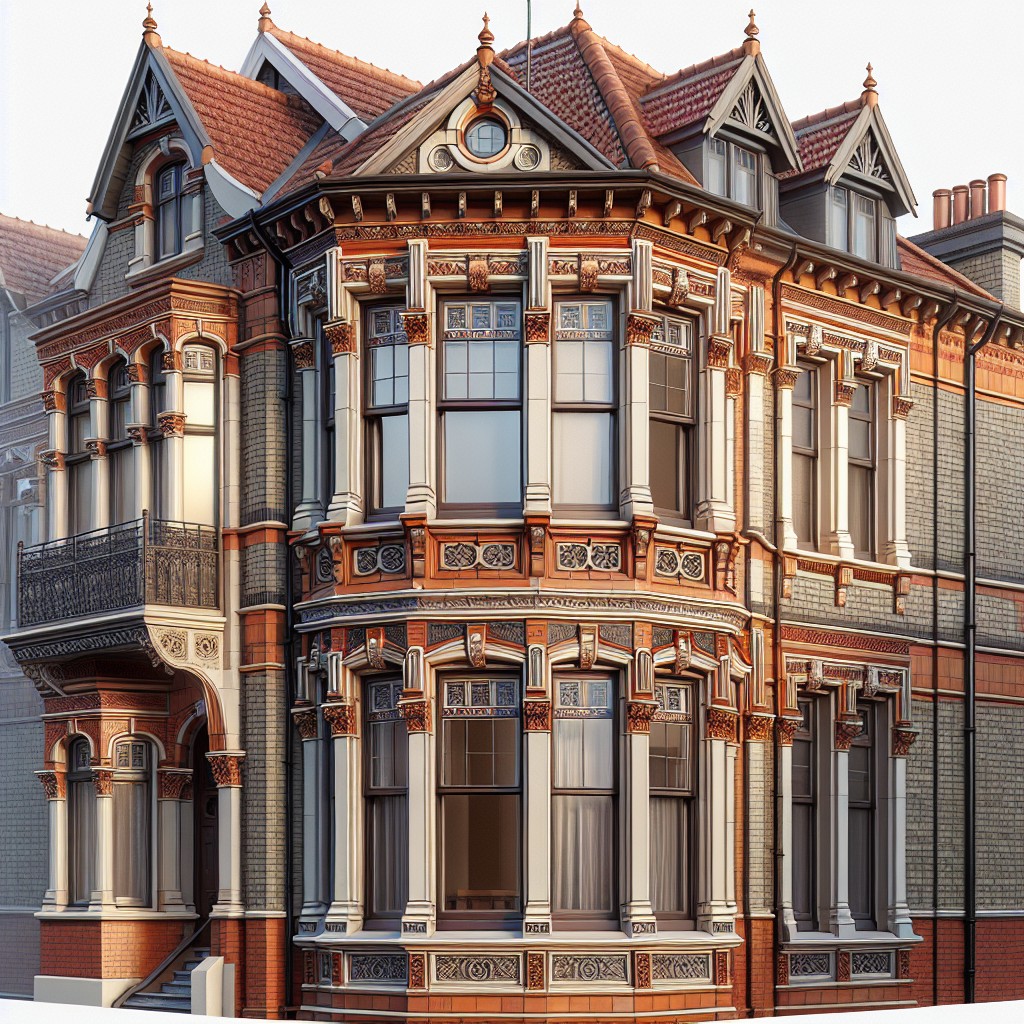
Defined by their classically elegant style, Edwardian era window trims exude an atmosphere of sophistication. They provide an essential cornerstone for creating an authentic period feel in a room.
Authentic replication of these trims contributes significantly to the overall interior design. Here are the key features:
- 1. Rich detailing: Often intricately carved trims showcase the craftsmanship of the era, adding depth and texture to windows.
- 2. Delicate motifs: Small embellishments still play a significant role in Edwardian styling, with floral, scroll, or leaf details commonly used.
- 3. Subdued tones: A color palette tends to rest on the subtle side, with whites, creams, and other soft shades predominating.
- 4. High-quality materials: Typically rendered in hardwoods such as oak or mahogany, the trims continue to display a sense of longevity and class.
- 5. Generous proportions: Larger, more elaborate trims pay homage to the opulence of Edwardian design, framing windows as pieces of artwork in the room.
Remember, these key features are not hard and fast rules, but a foundation for instilling Edwardian elegance into your aesthetics. Enjoy the process of picking the perfect Edwardian era window trim for your home. It can add a historic, refined touch to any room.
French Rococo Window Trim
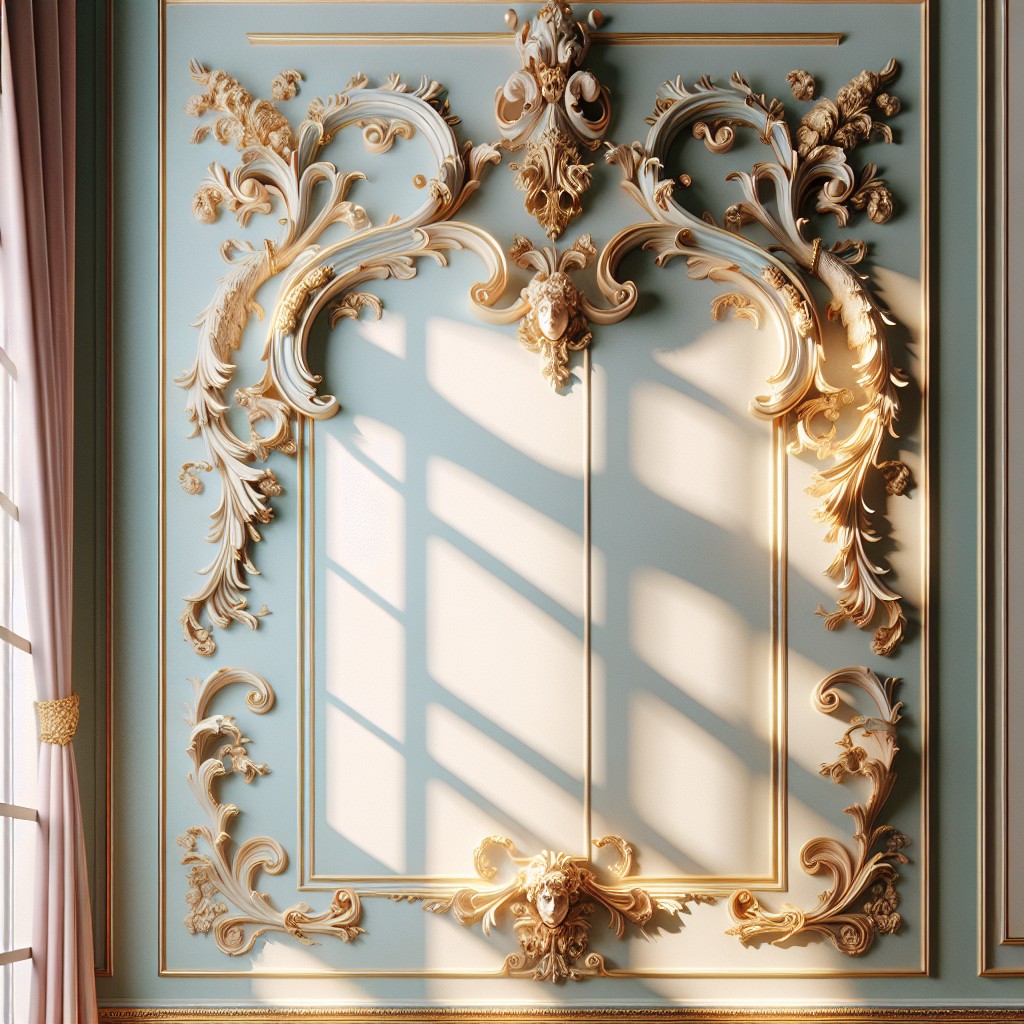
Distinguished by elaborate carvings, this style offers a high level of artistry. Originating from the 18th century France, it bears the hallmark of the opulence of Louis XV’s reign.
1. Use of Curves: Unlike other trim styles, rococo favors serpentine lines and natural forms, often incorporating floral or scroll designs.
2. Carving Detail: The high level of intricate carving is a definitive element of rococo window trims.
3. Material Choice: Wood is the most common material, painted to give an impression of richness that matches the detailed carving.
4. Elegance and Opulence: The rococo style is the epitome of extravagance, perfect to emphasize the aesthetic grandeur of your home.
With its ornate designs and historical roots, a rococo window trim can add a touch of grandeur to your house. But remember, it might be best suited for a room or house that carries a similar level of elegance and decoration.
Provincial Style Window Trim
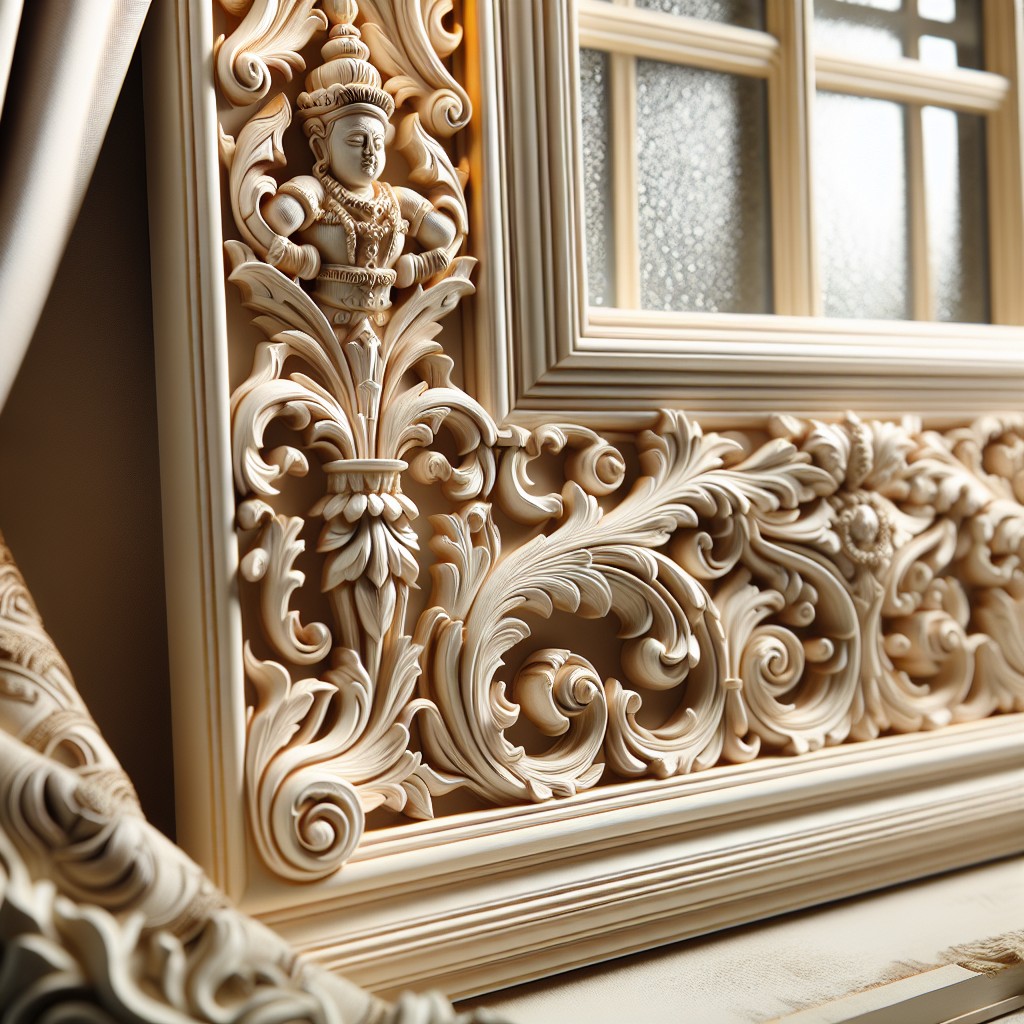
Drawing from the simplicity and rustic elegance of rural France, this trim style offers understated charm. Typically, provincial style involves hand-carved wood, with asymmetrical patterns to evoke the natural asymmetry of the countryside.
The focus is on textured finishes that add depth and character. Light, neutral colors are often utilized to accentuate the artisanal details and maintain a warm, inviting atmosphere. Such trim pairs well with both traditional and modern interiors, melding beautifully with natural elements like stone, exposed wood beams, and wrought-iron accents.
There’s often a hint of romance and nostalgia associated with the provincial style, making it a go-to choice for homeowners seeking a comfortable, lived-in aesthetic with a touch of sophistication.
Renaissance Revival Window Trim
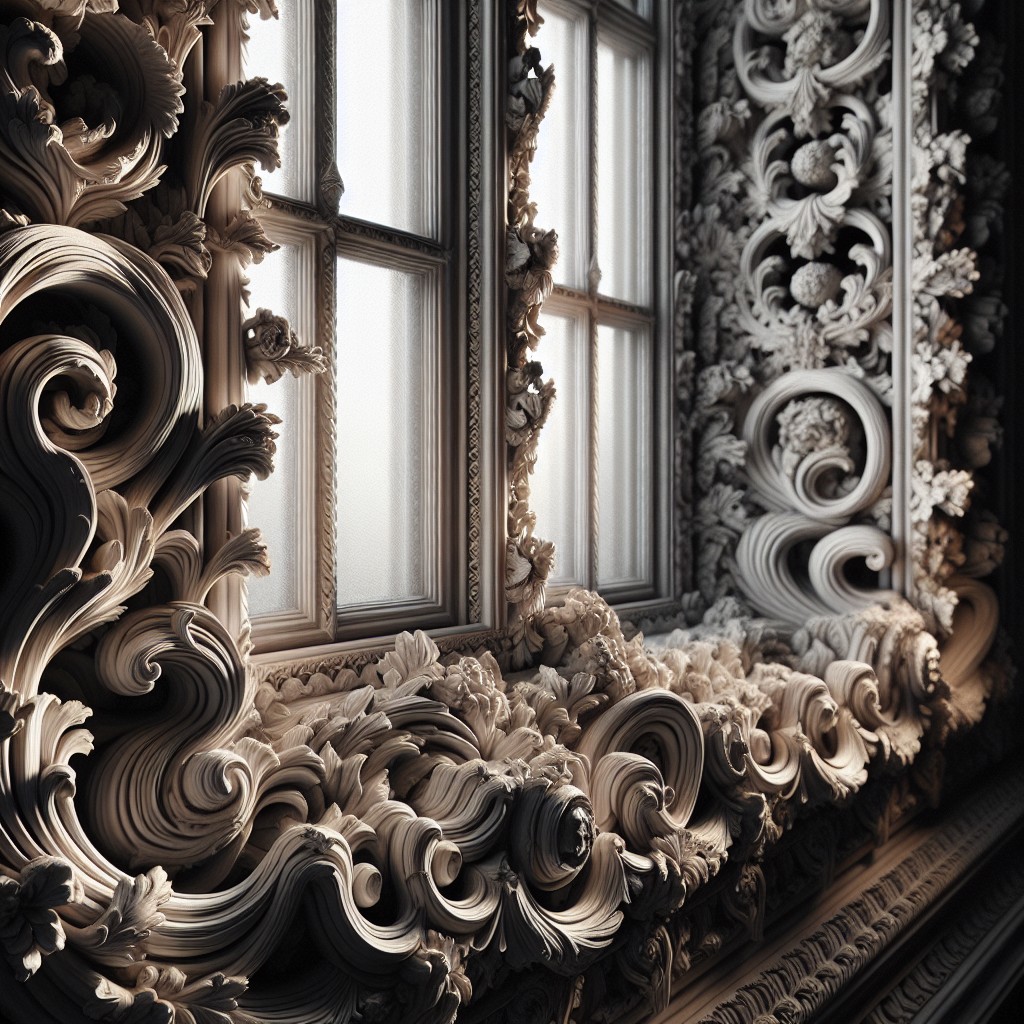
Designing in the style of the 15th and 16th-century European Renaissance, this aesthetic reflects an aristocratic and intellectual sophistication. It favors detailed embellishments and is characterized by complex geometry, proportion, and symmetry. Focal points are carefully amplified with motifs such as medallions or rosettes.
Major components:
- Robust wooden frames with ornate carvings.
- Traditional motifs of the period, such as flora, fauna, or faces.
- Symmetric designs, always balanced and neat.
- Usage of darkly stained or painted wood to mimic the rich texture of the original period.
- Squares and rectangles are the preferred shapes, but arches can also be used.
- Medallions or rosettes at the corners or center.
This choice imparts grandeur and a sense of history but remember to balance it with minimalistic decor to avoid overwhelming the living space.
Ideas Elsewhere
- https://www.soulandlane.com/window-trim-ideas-2540/
- https://www.familyhandyman.com/list/interior-window-trim-ideas/
- https://brennancorp.com/blog/interior-window-trim-options/
- https://belcofp.com/exterior-window-trim-ideas/
- https://www.royalbuildingproducts.com/liveabode/the-art-of-window-trim-creative-ideas-to-add-personality-to-your-homes-exterior/
- https://www.southernliving.com/home/interior-window-trim-ideas


